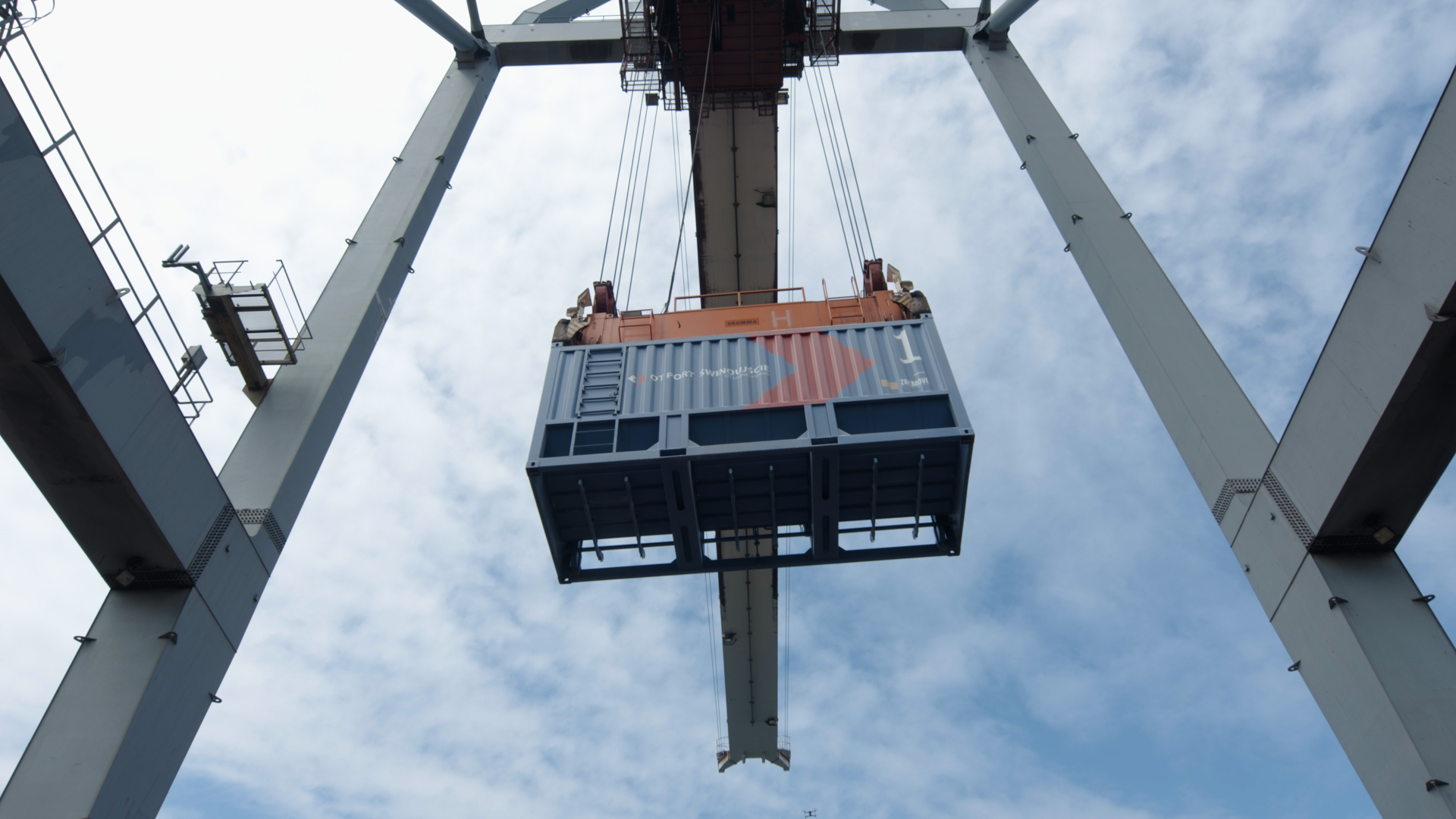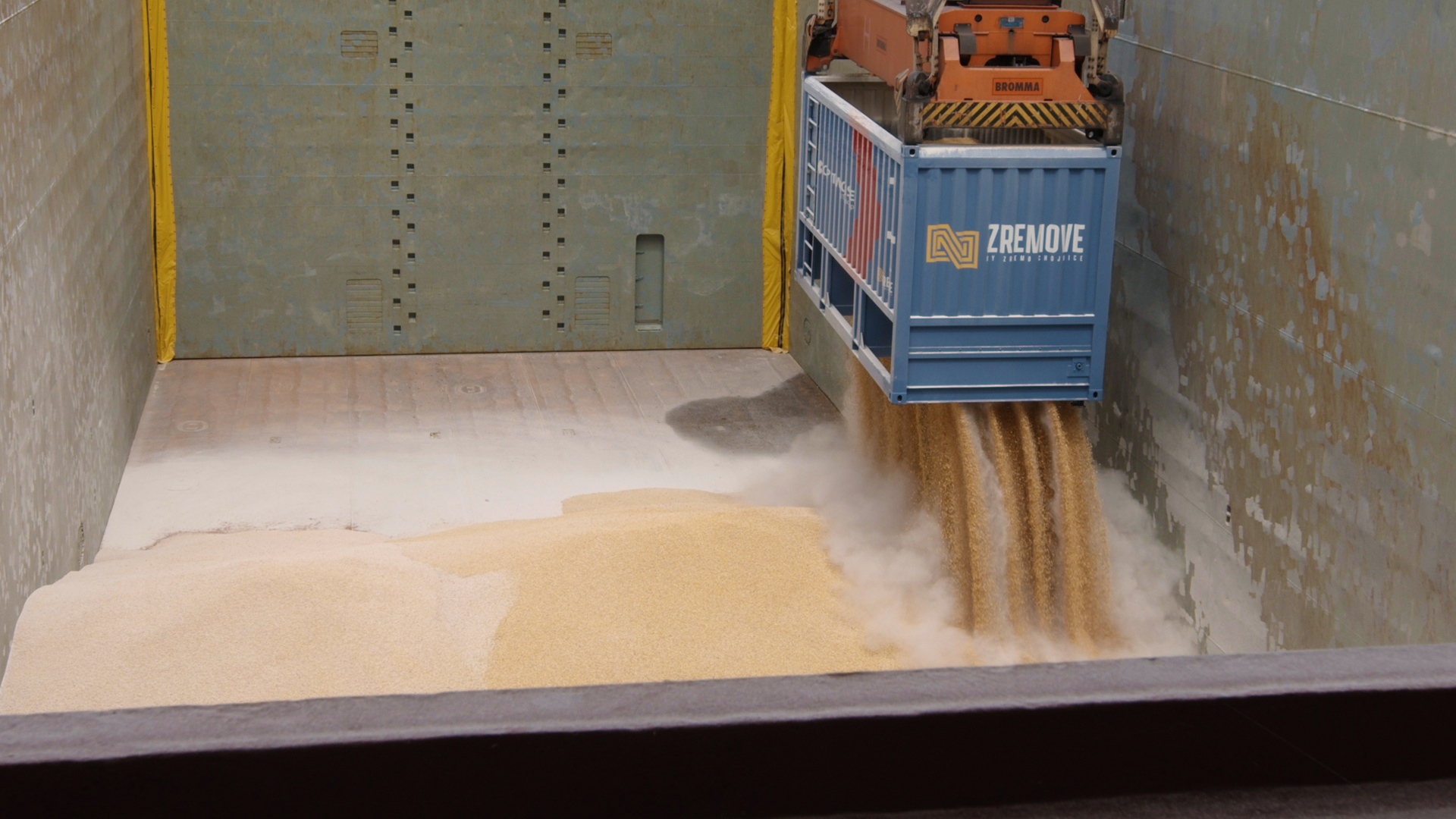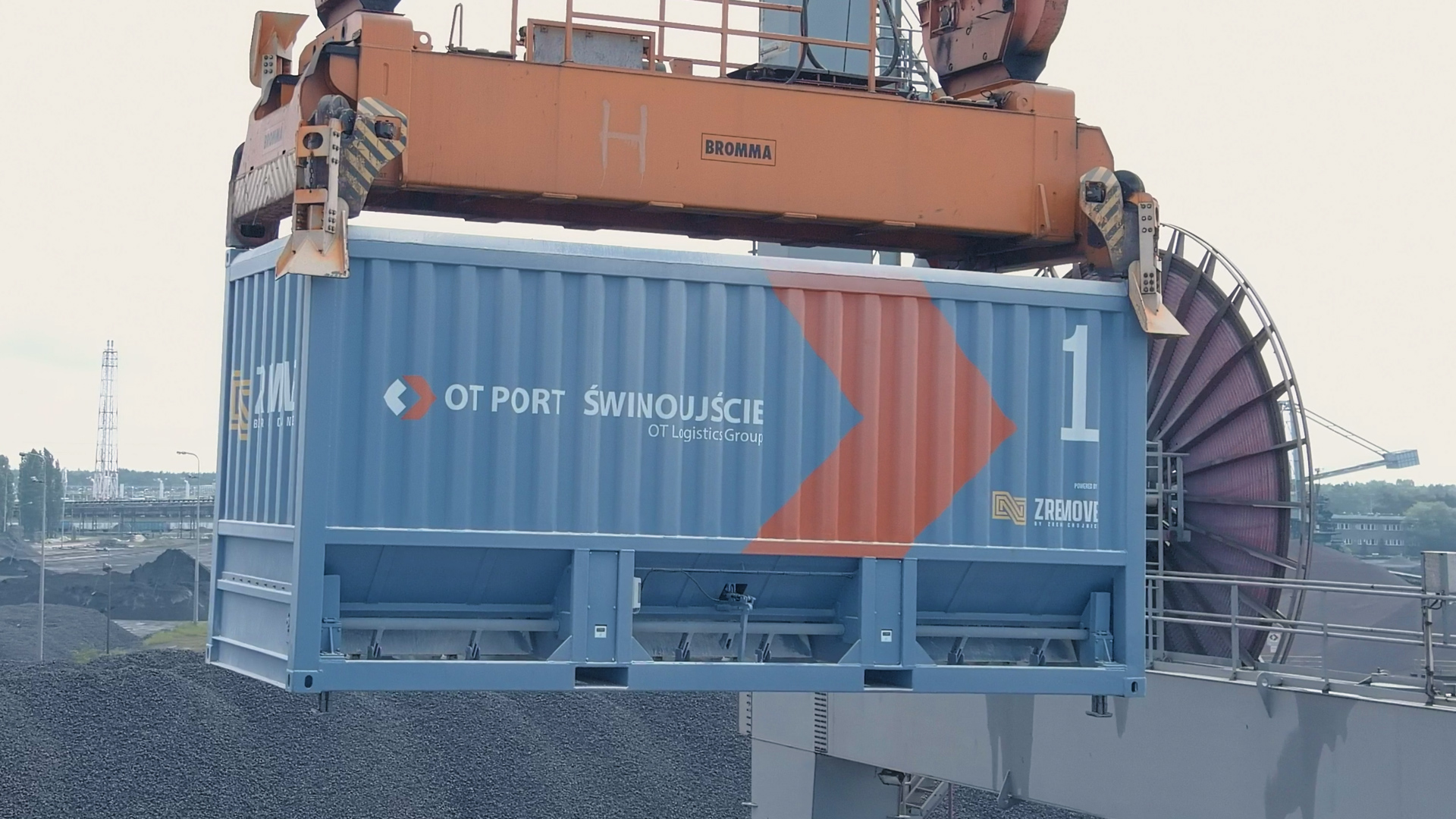![Specialized container from Chojnice will improve grain transportation [VIDEO] - MarinePoland.com Specialized container from Chojnice will improve grain transportation [VIDEO] - MarinePoland.com](https://www.marinepoland.com/zdjecia/artykul/1604/6472/1200x0/2/MAIN.00_00_31_10.Still003.jpg)
Grain transportation has unexpectedly become one of the most important topics of the season, which is obviously due to the conflict in Ukraine. Media attention has focused on technical problems, among others, but some light should fall on the invention of Zremb Chojnice, which can solve many of them.
Zremove is a container adapted for
the transport and handling of grain and other small-grain bulk
materials. Although it may seem strange, until now there was no
suitable solution that would allow easy and fast loading and, what is
more difficult, unloading of such goods. The topic was finally
approached by container specialists from Zremb Chojnice. The Zremove
container they developed is already in operation at one of the
transshipment terminals, but its potential is much greater.
Three years of work
- We
are looking for areas where we can offer the market solutions that
require more advanced technical knowledge in container construction,
and at the same time ones that would be accepted in this market -
describes the nature of Zremb Chojnice its president, Krzysztof
Kosiorek-Sobolewski.
This is how the company began to
look at the topic of containers that would allow easy intermodal
transport of grain. It came up in conversations with industry
players. It turned out that there are quite a few problems with this.
There are containers with side chutes, but they have to be lifted to
spill the material out of them. There are railcars, which PKP Cargo
has in its fleet, for transporting grain or fertilizers, but they
require advanced infrastructure to empty them. There is a lack of a
dedicated solution for this type of cargo on the market.
- We like challenges. We often get
a task from customers to design and manufacture a container for
specific functions. We work on it, prepare designs, when the customer
accepts it, we produce a prototype or a few pieces and deal with the
formalities of readying them for use. It takes 10-20 percent of our
working time. We took the same approach in 2019 with container
dedicated to grain - Kosiorek-Sobolewski recalls.

However, before the Zremove
container appeared on the drawing boards and computers of engineers,
it was necessary to do some research.
- At first it was limited, then we
asked more broadly. We mainly talked to important players in
intermodal transport. They told us that such a solution would indeed
be useful, and some companies approached it to create a complementary
container with bottom chute capability. No one has so far succeeded
in solving all the problems that arose during the work on such a
container - says the president of Zremb, who describes himself as the
father of the project.
After several months of work, the
first Zremove prototype was created. The developed container is open
from the top (it is closed with a system of tarpaulins for transport
or storage), but it is emptied from the bottom – the bottom opens
completely. Thus, all you need to do is load and transport it, and
unloading is trivial - container can be lifted with any reach stacker
or forklift and opened with a remote control - the grain will be
discharged from the bottom. It sounds simple, but despite
appearances, there were many pitfalls along the way to its
development.
From farmer to port
In
order to develop a suitable solution and not get caught in the
lurking design traps, Zremb engineers first had to determine how
their product would work and what tasks it should perform. They
therefore specified the standard logistic chain for grain
transportation, from the moment it is loaded at the farmer's, to
reaching its destination point, which is the ship's hold.
The longest version of this chain
assumes that the farmer dumps the grain onto his trailer, which he
then pulls to the collection point. There, the grain is sucked
directly from the trailer into an elevator or unloaded into a yard
and then transferred to covered storage facilities. Then it must be
loaded onto a train or truck. If the collection point has access to a
rail siding, it can simply be transferred to railcars using
bulldozers. In other cases, it lands on truck trailers. It goes to
the port, where it is again dumped, stored and waits for the ship.
The last point is the ship's hold, where the grain travels to the
destination port for further distribution. Such a chain is an ordeal
- it's long, requires multiple transfers of grain, resulting in
losses, usually of several percent. That also means, there are plenty
of problems waiting to be solved.
Zremb's engineers also had other design assumptions.
- We assumed that it would be a
container with the simplest possible design of the trigger mechanism.
We also assumed that, due to the nature of the chain, it would be
filled once or twice a day and as many times dumped, meaning that it
would open and close relatively infrequently - describes
Kosiorek-Sobolewski. - There were ideas in which the lower flap, when
opened, went outside the container's outline. We wanted that not to
be the case. We raised the system up a bit. This took away some space
- the container has 2 or 3 cubic meters less capacity. However, we
fit within the outline of a standard container - he adds.
The developed Zremove container
solves quite a few problems in the grain supply chain. It is a
classic 20-foot container, so truck will fit two pieces. They can be
provided for the farmer, who fills them with his grain. The full
containers are then loaded onto the rail system or onto a truck,
through which they go to a collection center or port. On site, they
don't need to be emptied while waiting for the next transport - the
containers can be stacked up to five levels, and for the duration of
transport and waiting, they simply need to be covered using a tarp
system. They can only be emptied into the ship's hold. Empty Zremove
can go on another journey or be loaded with another neutral material
that will not cause the container to be washed, such as pellets.
- The use of Zremove containers
evidently speeds up the process. If the number of such containers in
use were greater, with one means of transport - this container - we
would be able to transport grain from producer to port without
transshipment points, which generate costs and losses - concludes
Kosiorek-Sobolewski.
Problems and evolution
The
solution seems simple. How is it possible that no one has previously
succeeded in developing an adaptable container for lightweight
materials that will open completely from the bottom and not cause
problems in operation?
- Airtightness. This is the number one problem. With larger-diameter materials, it would be more manageable. With grains, where the individual pieces are small in diameter, everyone had a problem with this - explains the president of Zremb Chojnice. Another difficulty was the aforementioned opening system, which would guarantee complete emptying of the container, without jamming and taking up too much space. In addition - the locking and opening system. - The container's opening mechanism is subject to various forces, including torsion, and they had to be taken into account in the design of the mechanism. We mastered this - adds Kosiorek-Sobolewski.

Once the prototype took physical form, it had to be properly tested. First, Zremb Chojnice employees tested the new product themselves.
- We conducted a lot of tests, on
various materials. We tested the number of closures, openings, on
grain, on aggregates. But real conditions are different from any
tests. We wanted to test the product in real work and improve it -
says the president of Zremb.
With help came OT Port Świnoujscie,
which ordered a package of this type of containers, which were to
work in the developed process line. But for the contractor's needs, a
few improvements had to be made, which raised Zremove to a new level.
- Because of their needs, the
container underwent an evolution going in the direction of a
reloading container. Originally, we assumed that it would be filled
and emptied once or twice a day. Meanwhile, OT Port Świnoujscie uses
it a little differently - when they transship grain there are several
hundred openings and closings per day. They work in a technological
sequence: storage - filling - transport - unloading. So we are at the
level of a transshipment container with a very high number of
opening/closing cycles. We have made quite a few changes. There are
electric actuators that open the container, special feet for closing,
there are sensors, because the whole thing works on remote control,
limit switches, two batteries. The container has been upgraded in
terms of electrics - describes Krzysztof Kosiorek-Sobolewski.
However, Zremove can now do much
more. In the maximum equipment version, the product can be
supplemented with an identification system using radio technology
(Internet of Things), which allows inventory and localization of
cargo, as well as remote activation of the container's mechanisms and
obtaining action confirmations. The container is available in two
versions adapted to different maximum diameter of granules - 30 mm
(e.g., cereals) and 70 mm (e.g., coke or coarser pellets). A larger
version - a 40-foot version - is also in development.

Will Zremove head out into the world?
Krzysztof Kosiorek-Sobolewski makes no secret of
the fact that this is just the beginning for Zremb Chojnice and their
new product. At the moment, the containers are working exclusively at
OT Port Świnoujscie, but news of them is slowly spreading and more
inquiries are coming to Chojnice. The company's management, however,
remains pragmatic.
- For the time being, we want to test Zremove on a wider scale, in real conditions. If there are any needs, we will gently adapt it to the customer's needs or the type of material it will transport. We would like it to be an ideal product - says Zremove's president.
At the same time Zremb hopes that
the container will be positively verified by the market and prove
itself to a greater extent. Several Polish entities and government
agencies that have been approached about Zremove have already
expressed interest. It has also been eyed for grain shipments from
Ukraine.
The creators of Zremove sees the market for the container among intermodal transport companies. Experience gained from the use of containers in Świnoujscie shows that the optimal situation would be if they were in common use. They would then arrive at the port on rail platforms, be removed and stacked in yards while waiting for a ship, after which the rail yard would be sent back. This form would be the simplest and most cost-effective for all involved in grain transportation. So Zremove has a lot of potential, and Zremb Chojnice hopes they can make it happen.
- If the system is accepted by the
market it is possible that it will be some kind of standard. I don't
know if that will be the case. However, I do know that it will
definitely be in use at least in some part. This container has a
chance to play no small role - Krzysztof Kosiorek-Sobolewski
concludes.


